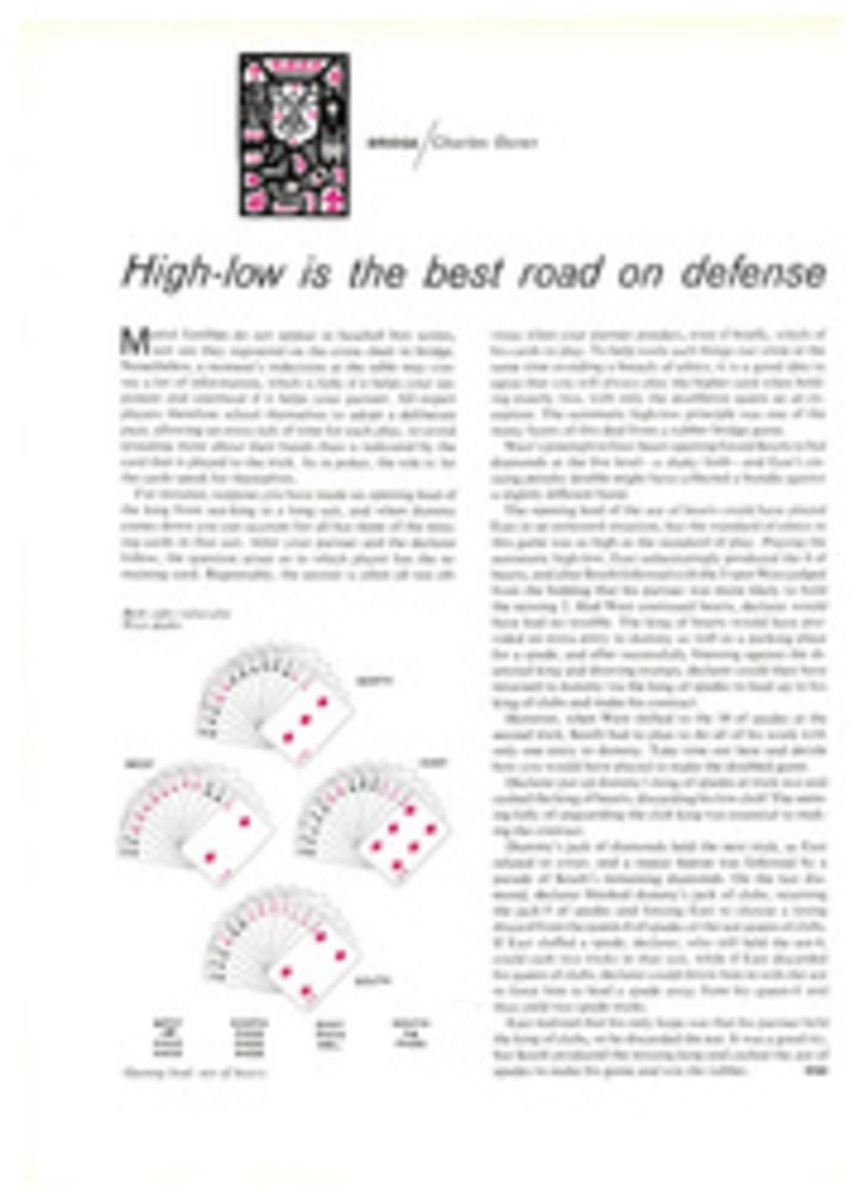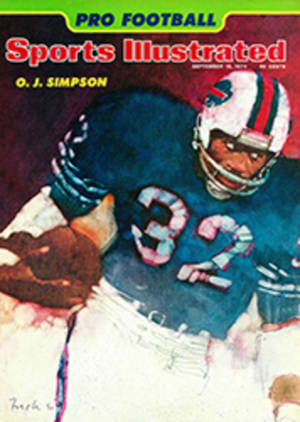
AMERICAN CENTRAL
It is the Year of the Tiger on the Chinese calendar, which could be prophetic for this division. The Bengals of Cincinnati won six straight games at the end of last season to edge past Pittsburgh for the division championship, and Coach Paul Brown's troops may just keep on winning.
Evidence of the Bengals' new stature came during the draft. In the first round Cincinnati selected Bill Kollar, a defensive tackle from Montana State. The defensive tackle spots on the Bengals are currently manned by All-Pro Mike Reid, who sang the national anthem in full uniform before one exhibition game this year, and Ron Carpenter, who led the front four in tackles and quarterback sacks last season. The message was clear: the Bengals already had first-line players at every position. Last year's draft had filled in the two remaining pieces of the puzzle, a wide receiver and a big running back.
Critics used to say that Cincinnati's quarterbacks could not throw deep, but then Isaac Curtis, a 9.3 sprinter, arrived and suddenly the Bengals were bombing. Curtis averaged 18.7 yards on his 45 receptions last season and scored nine touchdowns, five of which were for 50 yards or more. With the new restrictions against the bump-and-run—referred to as "the Isaac Curtis rule"—he figures to do even better.
In the 12th round of that draft, Brown finally found the type of big back he had always had in Cleveland. Tight End Boobie Clark from tiny Bethune-Cookman was converted to running back and imitated Marion Motley so well that he won the AFC's Rookie of the Year award. Clark gained 988 yards and caught 45 passes for 347 more. Now he says, "I don't plan to take the bumps and bruises. This time I'm going to dish it out." It was apparent when Boobie reported to camp that he had been dishing it in all winter. Brown had to send the team trainer through the chow line with him to watchdog his calories.
The departure of Bill Bergey, traded to Philadelphia after a court fight over his defection to the WFL, left the middle linebacker job open, but the spot was quickly seized by Jim LeClair, an outside linebacker who was moved to the middle after he ignored the strike and reported the first day of practice. No one questions LeClair's strength—least of all Victor, the wrestling bear, whom he pinned this spring—but he is not as mobile as Bergey. And while Quarterback Ken Anderson played like an old pro last year, he has only three years' experience. If he is injured, the Bengals will be vulnerable. Anderson's backup, Wayne Clark, couldn't make the grade in four years at San Diego.
In Pittsburgh, the quarterback position is worrisome, too, although here depth is not the problem. The Steelers have Terry Bradshaw, Terry Hanratty and Joe Gilliam—and each wants to be the starter. Bradshaw is the incumbent and has been since he arrived as a rookie in 1970. He has had spurts of brilliance but has never shown real consistency. Hanratty decided against a move to the WFL when Coach Chuck Noll assured him an equal shot at the No. 1 job, but he stayed out of camp during the entire strike and fell far behind his competition in the hurry-up to get ready for the regular season. That leaves Gilliam—Jefferson Street Joe—a 23-year-old black quarterback with minimal experience who passed opponents dizzy in the preseason and was named to open against Baltimore. All three could take turns starting, as they did last year, but that is likely to produce the same lack of offensive consistency that has plagued Pittsburgh.
The 1973 Steelers badly needed depth at wide receiver, and in that regard the draft was a bonanza. In the first round they chose USC's Lynn Swann and in the fourth round they got what may be the real steal: John Stallworth from little Alabama A&M. When Pittsburgh received a film on Stallworth from his school, it carried instructions to pass it on to the other teams in the BLESTO-VIII scouting combine. The Steelers took one look and conveniently lost the film, which helps explain why Stallworth was still available in the fourth round. Pittsburgh might have used its first-round choice for him had Swann not been available.
But if Pittsburgh's passing game appears better, its once-powerful running game seems worse. Two years ago the Steelers led the league with a rushing average of 5.1 yards a carry. Last year that figure fell to 3.9. Franco Harris was hurt much of the year. Now that he is presumably healthy again he has not shown the verve that won him Rookie of the Year honors in 1972. Steve Davis, a 218-pound speedster, has taken the other backfield post from the flashy Frenchy Fuqua.
The Steelers' forte is still defense, particularly the front line, where Mean Joe Greene, Dwight (Mad Dog) White, Ernie Holmes and L.C. Greenwood terrorize the opposition. Pittsburgh recorded 33 sacks last year, a figure that certainly would have been higher had opposing quarterbacks not been in such a hurry to get rid of the ball. A better indicator of the defensive line's prowess was the 37 Steeler interceptions, 11 more than any other team in football. Altogether, the Steelers forced a league-high 55 turnovers.
Second-round draft choice Jack Lambert has drawn rave reviews and could replace veteran Henry Davis at middle linebacker; the corner-back spot vacated by John Rowser, who was traded to Denver, will be filled by J.T. Thomas, the Steelers' first-round pick in last year's draft.
Noll should have no trouble becoming the first Pittsburgh coach to put together three consecutive winning seasons, and his Steelers probably will battle the Bengals right down to the wire. Indeed, the division title could well be decided in the final game of the season when the two teams meet in Pittsburgh.
Not that you can ever count the Cleveland Browns out of a race. In their 28-year history the Browns have had only one losing season. A decline was predicted last year, but going into the 13th week the Browns stood at 7-3-2, right in the thick of the division race. Then Cleveland lost its last two games—to Cincinnati and Los Angeles—to finish third.
Third place again seems inescapable for the Browns. Last year they could not score a touchdown against Miami, Minnesota and the Giants and in one of their two games with Pittsburgh. Cleveland's offensive line just ain't what it used to be. Old pro Gene Hickerson has retired and most of the returning veterans are coming off surgery. The pass protection last year was the poorest in the team's history; as a result, Cleveland averaged 3.9 yards per pass attempt, next to worst in the league. Quarterback Mike Phipps has yet to prove that he is anything more than a bundle of unrealized potential, and his receiving corps is thin. The Browns are counting on drastic improvement from last year's No. 1 draft choice, Wide Receiver Steve Holden, who in 1973 caught only three passes for 27 yards.
Cleveland's ground game was equally weak, averaging 3.9 yards a crack. Leroy Kelly has been waived to Oakland, and now the thrust of the Browns' running attack rests on the shoulders of 5'10", 190-pound Greg Pruitt. Pruitt is in a class by himself in the open field and should be an enormous asset under the new punt coverage rule, but it is doubtful that he will be able to gain substantial yardage by throwing himself into the center of the line.
The Browns' defense is strongest up the middle. Tackles Walter Johnson and Jerry Sherk are a superb tandem and Middle Linebacker Bob Babich, fully recovered from knee surgery, gives Cleveland its best performer at that position in years. The defensive backs are much better than their 12 interceptions (second-lowest in the league) indicate; they need defensive ends who can put pressure on opposing quarterbacks.
Sid Gillman's Houston Oiler reclamation project goes on...and on. Gillman has brought organization and savvy to the team, but someone should have given him a course in human relations. "If I can win," he says, "everybody can hate me. I'll give them a license to despise me if I can win."
Oiler players don't seem to require a license nor do they appear to be in immediate danger of winning any football games. Gillman alienated his veterans with comments he made during the strike and then cut seven of them the day they arrived in camp, including Linebacker Paul Guidry, who had driven 26 hours straight from Buffalo. That prompted Defensive End Elvin Bethea, the team's best player, to ask to be traded. "He's making the whole franchise go backward," said Bethea of his coach.
Gillman continues to trade draft choices. He recently dealt a first in 1976 and a third in 1977 for San Francisco Running Back Vic Washington. In the first six rounds of this year's draft the Oilers had only one selection left, and that for the fourth round. Their pick, Steve Manstedt, a linebacker from Nebraska, promptly signed with the WFL. And their No. 1 draft pick a year earlier, 6'8", 290-pound Defensive Tackle John Matuszak, left the Oilers during training to join the WFL's Houston Texans. Litigation followed, of course.
On offense, which the Oilers play without benefit of blocking, Houston led the league with 52 turnovers. On defense, Gillman is experimenting with a permanent type of "53" alignment that utilizes four linebackers and three defensive linemen. That seems strange in light of his admission that "We had the worst line-backing I've ever seen in pro football." But with only two wins in two seasons, things have to get better, don't they? Well, don't they?
ILLUSTRATION
DAVID LEVINE
Nick Skorich: CLEVELAND BROWNS
ILLUSTRATION
DAVID LEVINE
Chuck Noll: PITTSBURGH STEELERS
ILLUSTRATION
DAVID LEVINE
Sid Gillman: HOUSTON OILERS

